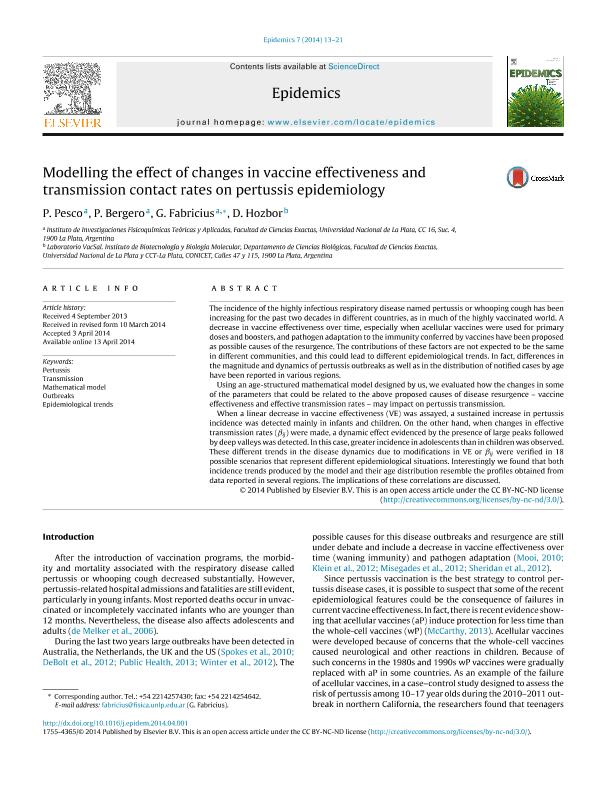Mostrar el registro sencillo del ítem
dc.contributor.author
Pesco, Pablo Sebastián
dc.contributor.author
Bergero, Paula Elena

dc.contributor.author
Fabricius, Gabriel

dc.contributor.author
Hozbor, Daniela Flavia
dc.date.available
2016-05-03T15:38:33Z
dc.date.issued
2014-05
dc.identifier.citation
Pesco, Pablo Sebastián; Bergero, Paula Elena; Fabricius, Gabriel; Hozbor, Daniela Flavia; Modelling the effect of changes in vaccine effectiveness and transmission contact rates on pertussis epidemiology; Elsevier; Epidemics; 7; 5-2014; 13-21
dc.identifier.issn
1755-4365
dc.identifier.uri
http://hdl.handle.net/11336/5471
dc.description.abstract
The incidence of the highly infectious respiratory disease named pertussis or whooping cough has been increasing for the past two decades in different countries, as in much of the highly vaccinated world. A decrease in vaccine effectiveness over time, especially when acellular vaccines were used for primary doses and boosters, and pathogen adaptation to the immunity conferred by vaccines have been proposed as possible causes of the resurgence. The contributions of these factors are not expected to be the same in different communities, and this could lead to different epidemiological trends. In fact, differences in the magnitude and dynamics of pertussis outbreaks as well as in the distribution of notified cases by age have been reported in various regions.Using an age-structured mathematical model designed by us, we evaluated how the changes in some of the parameters that could be related to the above proposed causes of disease resurgence -vaccine effectiveness and effective transmission rates - may impact on pertussis transmission.When a linear decrease in vaccine effectiveness (VE) was assayed, a sustained increase in pertussis incidence was detected mainly in infants and children. On the other hand, when changes in effective transmission rates (βij) were made, a dynamic effect evidenced by the presence of large peaks followed by deep valleys was detected. In this case, greater incidence in adolescents than in children was observed. These different trends in the disease dynamics due to modifications in VE or βij were verified in 18 possible scenarios that represent different epidemiological situations. Interestingly we found that both incidence trends produced by the model and their age distribution resemble the profiles obtained from data reported in several regions. The implications of these correlations are discussed.
dc.format
application/pdf
dc.language.iso
eng
dc.publisher
Elsevier

dc.rights
info:eu-repo/semantics/openAccess
dc.rights.uri
https://creativecommons.org/licenses/by-nc-nd/2.5/ar/
dc.subject
Pertussis
dc.subject
Transmission
dc.subject
Mathematical Model
dc.subject
Outbreaks
dc.subject
Epidemiological Trends
dc.subject.classification
Matemática Aplicada

dc.subject.classification
Matemáticas

dc.subject.classification
CIENCIAS NATURALES Y EXACTAS

dc.subject.classification
Enfermedades Infecciosas

dc.subject.classification
Ciencias de la Salud

dc.subject.classification
CIENCIAS MÉDICAS Y DE LA SALUD

dc.title
Modelling the effect of changes in vaccine effectiveness and transmission contact rates on pertussis epidemiology
dc.type
info:eu-repo/semantics/article
dc.type
info:ar-repo/semantics/artículo
dc.type
info:eu-repo/semantics/publishedVersion
dc.date.updated
2016-05-06 15:52:43.262787-03
dc.journal.volume
7
dc.journal.pagination
13-21
dc.journal.pais
Países Bajos

dc.journal.ciudad
Ámsterdam
dc.description.fil
Fil: Pesco, Pablo Sebastián. Consejo Nacional de Investigaciones Científicas y Técnicas. Centro Científico Tecnológico la Plata. Instituto de Investigaciones Fisicoquímicas Teóricas y Aplicadas; Argentina. Consejo Nacional de Investigaciones Científicas y Técnicas. Centro Científico Tecnológico La Plata. Instituto de Biotecnología y Biología Molecular; Argentina
dc.description.fil
Fil: Bergero, Paula Elena. Consejo Nacional de Investigaciones Científicas y Técnicas. Centro Científico Tecnológico la Plata. Instituto de Investigaciones Fisicoquímicas Teóricas y Aplicadas; Argentina. Consejo Nacional de Investigaciones Científicas y Técnicas. Centro Científico Tecnológico La Plata. Instituto de Biotecnología y Biología Molecular; Argentina
dc.description.fil
Fil: Fabricius, Gabriel. Consejo Nacional de Investigaciones Científicas y Técnicas. Centro Científico Tecnológico la Plata. Instituto de Investigaciones Fisicoquímicas Teóricas y Aplicadas; Argentina. Consejo Nacional de Investigaciones Científicas y Técnicas. Centro Científico Tecnológico La Plata. Instituto de Biotecnología y Biología Molecular; Argentina
dc.description.fil
Fil: Hozbor, Daniela Flavia. Consejo Nacional de Investigaciones Científicas y Técnicas. Centro Científico Tecnológico la Plata. Instituto de Biotecnología y Biología Molecular; Argentina. Consejo Nacional de Investigaciones Científicas y Técnicas. Centro Científico Tecnológico La Plata. Instituto de Biotecnología y Biología Molecular; Argentina
dc.journal.title
Epidemics
dc.relation.alternativeid
info:eu-repo/semantics/altIdentifier/url/http://www.sciencedirect.com/science/article/pii/S1755436514000188
dc.relation.alternativeid
info:eu-repo/semantics/altIdentifier/doi/10.1016/j.epidem.2014.04.001
dc.relation.alternativeid
info:eu-repo/semantics/altIdentifier/doi/http://dx.doi.org/10.1016/j.epidem.2014.04.001
Archivos asociados
